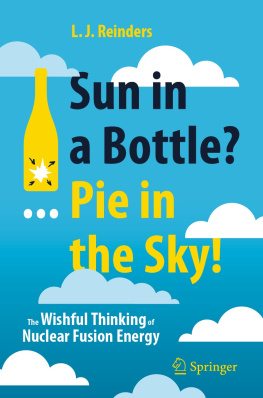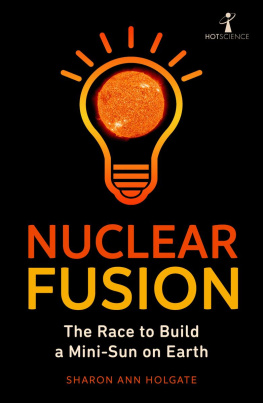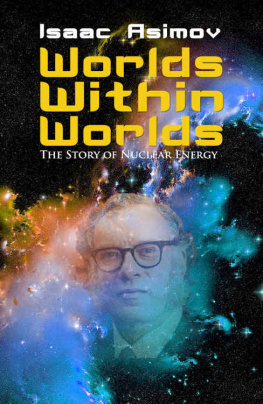The Star Builders
Nuclear Fusion and the Race to Power the Planet
Arthur Turrell
Thank you for downloading this Simon & Schuster ebook.
Get a FREE ebook when you join our mailing list. Plus, get updates on new releases, deals, recommended reads, and more from Simon & Schuster. Click below to sign up and see terms and conditions.
CLICK HERE TO SIGN UP
Already a subscriber? Provide your email again so we can register this ebook and send you more of what you like to read. You will continue to receive exclusive offers in your inbox.
For Alice
PROLOGUE A CRAZY IDEA
We need a massive amount of research into thousands of new ideaseven ones that might sound a little crazy.
Bill Gates, talking about ways to solve the energy crisis
My star-building adventure starts at a restricted-access nuclear facility fifty miles east of San Franciscos Financial District. The building Im in is the size of three football fieldsAmerican football fields, naturally. Its called the National Ignition Facility, or NIF. Within, scientists are pushing matter to its limits, re-creating the conditions and reactions that happen inside stars.
My guide is Dr. Bruno Van Wonterghem, the operations manager for NIF. Back in 1998, he helped design the enormous facility in which we now stand. (It would be over a decade before the machine created at this site was turned on.) What he and the other NIF scientists have built here under the Californian sunshine is the worlds biggest and highest energy laser.
Im here to see what happens when this huge laser fires. Its so powerful that it can only be used in brief spurts, momentary pulses each of which the scientists call a shot. As I wait nervously with Bruno, the director of this particular shot enters, his radiation leak detection badge swinging from his shirt, and calls us to the control room.
As we enter the darkened space, I see that its laid out like NASAs ground control: computer terminals encased in plastic arranged in curved rows; operators peering at graphics, lines of computer code, and scrolling text. Perhaps Bruno knows what Im thinking because he tells me that the laser system Im viewing is at least as complex as the space shuttle, with 5 million lines of computer code running the show. In front of us, screens cover the wall. Bruno sees me look at the color-filled panels. Thats the list of checks that have to be completed.
An hour earlier, screens dotted around the facility began to show a colored map of the laser system. Messages sent out over the public address system instructed people to leave laser bay 1 now, I repeat and, later, to leave laser bay 2. In an abundance of caution, each bay was then carefully swept to ensure it was empty of human life. As each inspection was completed, the map of the facility began to show red segments indicating that this or that area was ready. The most complex shots take thirty hours of preparation.
In the control room, I glance behind me and see a couple of people looking nervously through the Plexiglas. One, a man in his mid-thirties with stubble, paces up and down. Its his experiment, and given that the typical target costs $100,000 to $150,000, you can understand why hes anxious. The National Ignition Facility, which is hosted at Americas Lawrence Livermore National Laboratory, conducts a range of experiments relating to science and national security. Todays shot is classified, so I dont find out too much about what the experiment isapart from that it concerns the survivability of materials that are subject to extreme radiation. What Im really here to learn about are the shots aimed at creating a tiny star in the reactor chamber.
As I wait, its almost silent apart from the crackle of a walkie-talkie as one of the twenty or so scientists communicates with colleagues across the building. Bruno says that theyre charging the power supply, the worlds largest capacitor bank, essentially a ginormous fast-release battery. When set off, it will loose four hundred megajoules of energy, equivalent to lighting four hundred sticks of dynamite.
The shot director begins the countdown, Ten nine, and the smaller rectangles on the big screens begin to flip from grays and reds to greens. Eight seven six, intones the shot director through the public address system, and I see the biggest red bar, for the capacitor bank, begin to fill with green. Sometimes theres a last-minute failure or a power supply fails and everything shuts down, Bruno says, and I anticipate a sudden failure, with all of the greens going to gray. But the countdown continues: five four three two one SHOT!
In the cable-choked master oscillator room behind me, a short beam of infrared light is created. Its just six meters (approximately twenty feet) long, equivalent to flipping a light switch on for twenty nanoseconds. It contains only a single nanojoule of light energy, nothing when you consider that it takes a whole joulea billion times moreto lift an apple one meter (approximately three feet).
The fledgling beam is split into two sets of twenty-four smaller beams by precisely engineered optics. Each set travels down optic fibers to two bays of amplifiers that run almost the length of the building. There, the beams get a 10 billion times boost in energy from another laser. This is merely the start. Again, the light is split, now into a total of 192 different beams traveling in parallel. Lenses are used to expand the width of each beam to the size of an adults chest. Any smaller, and the sheer intensity of the light would irrevocably damage the glass as the beams passed through it.
The capacitors, brimming with electrical energy and each weighing eleven tons, reach a peak power of a terawattgreater than the entire US national gridas they fire more than seven thousand xenon flashlamps. The lamps are similar to those used by photographers, except here, where extremes are common, theyre stacked two meters (six and a half feet) high and cooled by nitrogen. The laser beams arrive and the flashlamps fire, streaking bright white light into huge slabs of neodymium-doped phosphate glass (it looks just like ordinary glass except for its pinkish tinge). As the glass absorbs the energy, the neodymium atoms within it enter an unstable, excited state. As the infrared laser beams sweep through the glass, the excited atoms relax, firing out their own infrared light. The effect is to amplify the surging laser beam many, many times over.
Mirrors, each minutely deformed by little motors, reflect the incoming beams perfectly evenly so that they go back and forth through the flashlamps for yet more amplification. Start to finish, the initial beam energy is boosted 4 million billion times over. Of the four hundred megajoules in the capacitors, less than 1 percent make it into the laser beam; nevertheless these 192 infrared beams comprise, by a wide margin, the most energetic laser pulse ever created.
The beams follow mirrored paths up, around, and along the building. They pass around the control room with Bruno and me inside. Theyre heading for the target chamber, their 1.5-kilometer (just under five thousand feet) trip nearing its end. Each beam passes through two giant slabs of crystal. The first changes the color of the incoming laser light, converting much of the infrared to a vibrant green. The two colors pass through a second slab of crystal where they mix like paint to make a third color of light. This new beam is packed with high-energy ultraviolet photons that are beyond our visual range.







